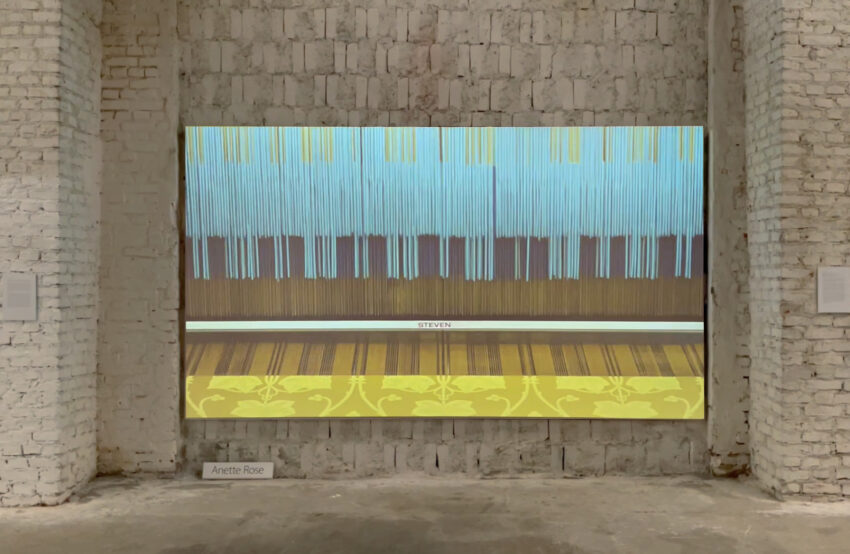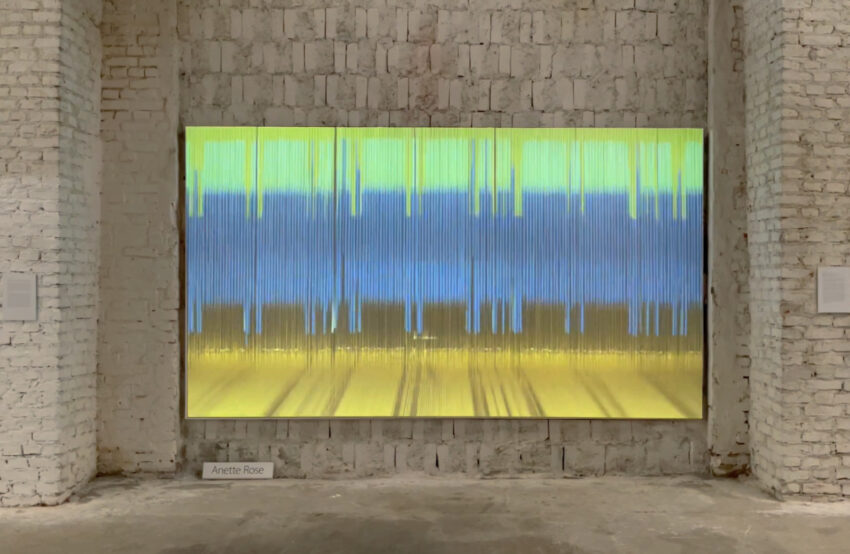Pattern in Motion
Pattern in Motion, Kunsthalle Bahnitz
As part of the exhibition ausgespielt
Enzyklopädie der Handhabungen. Modul #29.2 seidenweben – automatisiert
Video-channel 2, 11:03 min, 4K, 16:9, Stereo, Loop, 2017
Die Entwicklung von Automaten diente nicht allein der Rationalisierung, sondern früh schon dem Spiel. Komplizierte Laufwerke ersetzten Handarbeit, animierten aber auch allerhand Figuren. Bevor Jacques de Vaucanson 1745 den ersten automatischen Webstuhl entwickelte, konstruierte er einen mechanischen Flötenspieler und seine berühmte Ente, die nicht nur flattern, schnattern und trinken, sondern dank chemischer Reaktionen sogar verdauen konnte. Vaucansons Webstuhl wurde 1805 von Joseph-Marie Jacquard durch ein System von Lochkarten optimiert. Damit stand dieser Webstuhl am Beginn der Digitalisierung.
Die Nähe von Automatisierung und Spiel wird auf einer ganz anderen Ebene auch in dem hier gezeigten Video, einem Teil der Zweikanalinstallation Pattern in Motion, deutlich: der Rhythmus der farbigen Litzen transformiert den programmierten, monotonen Webprozess in einen audiovisuellen Beat.
Die Aufnahmen zeigen das Fadenspiel eines vollautomatisierten Jacquardwebstuhls. Sie wurden in der Seidenmanufaktur Eschke in Crimmitschau gefilmt, die auf die fadengenaue Rekonstruktion historischer Stoffe spezialisiert ist. Auf dieser Webmaschine entstehen florale Ornamente im Auf und Ab der digital gesteuerten Litzen, die ein abstraktes Bewegungsdiagramm bilden. Der Blick wird zwischen dem entstehenden Ornament und dem codierten Musterungsprozess der Litzen hin und her gelenkt. Die Arbeit zeichnet sich durch eine Spannung zwischen strenger, minimalistischer Form und üppigen Mustern und Farben aus. Aus den, dem Jacquardweben zugrunde liegenden, abstrakten Rechenoperationen, dem Code von Null und Eins, wird ein rhythmisches Spiel mit Farben und Formen.
Kunsthalle Bahnitz
Dorfstr.1, 14715 Bahnitz
Sa-So von 11-17 Uhr
(English version)
The development of automata was not solely for rationalization, but early on for play. Complicated drives replaced manual labor, but also animated all sorts of figures. Before Jacques de Vaucanson developed the first automatic loom in 1745, he constructed a mechanical flute player and his famous duck, which not only fluttered, quacked and drank, but could even digest thanks to chemical reactions. Vaucanson’s loom was optimized in 1805 by Joseph-Marie Jacquard through a system of punched cards. This loom thus marked the beginning of digitization.
The proximity of automation and play is also evident on a completely different level in the video shown here, part of the two-channel installation Pattern in Motion: the rhythm of the colored heddles transforms the programmed, monotonous weaving process into an audiovisual beat.
The footage shows the thread play of a fully automated jacquard loom. They were filmed at the Eschke silk manufactory in Crimmitschau, which specializes in the thread-accurate reconstruction of historical fabrics. On this loom, floral ornaments are created in the up and down of the digitally controlled healds, forming an abstract diagram of movement. The eye is drawn back and forth between the emerging ornament and the coded patterning process of the healds. The work is characterized by a tension between strict, minimalist form and lush patterns and colors. The abstract arithmetic operations underlying jacquard weaving, the code of zero and one, becomes a rhythmic play with colors and shapes.

